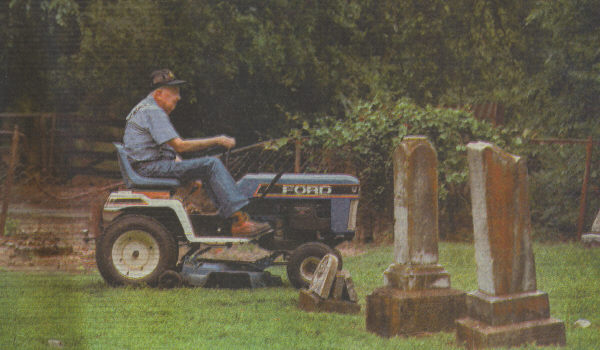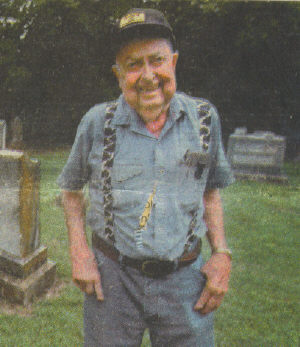|

Fred Marsh tends a cemetery that stands on
land his family has owned for 150 years. "Now people have
started using it again," he says.
GRAVE CONCERN
Amid the encroachment of suburbia, a forgotten cemetery benefits from loving
attention.
Dallas Morning News on Monday, June 2 1997
By Bryan Woolley, Staff Writer of The Dallas Morning News.
Farmers Branch----- They were just passing through. They had two little
girls. The little girls died. They buried them in a pasture and placed two
ordinary field rocks at the heads of their graves. Then they moved on. “The
cemetery started from there,” says Fred Marsh Jr. “I have no idea who those
people were or where they went or when it was. It was way on back.”
Harrison C. Marsh was buried near the little girls in 1882, and T. C. Marsh
in 1889. Their tombstones are among the oldest and tallest in the patch of
pasture that became their family cemetery.
Fred Marsh remembers it from
his childhood. It was fenced off from the rest of the pasture. A single
cedar stood between the graves of the two girls. He would see it when he
visited his grandmother on her nearby farm.
“There wasn’t a lot out here when I was a kid.” he says, “You wouldn’t
believe how much difference there is, how pretty it was then and how bad it
looks now. To me anyway. This was really a pretty place. It was just a big
old pasture. It had sheep in it. The creek --- Farmer’s Branch --- ran all
pretty and clear. There was a grist mill right on the side of a hill. It was
a pretty place.” how pretty it was then and how bad it
looks now. To me anyway. This was really a pretty place. It was just a big
old pasture. It had sheep in it. The creek --- Farmer’s Branch --- ran all
pretty and clear. There was a grist mill right on the side of a hill. It was
a pretty place.”
Fred was a town boy. His father ran a garage in downtown Farmer’s Branch.
Fred eventually bought him out and followed in his footsteps. Around 1946
the town started to grow, and in 1952, Mr. Marsh and his wife, Jean, built
the white frame house where they still live.
It stands on land his family has owned for more than 150 years. It used to
be part of the big pasture. Now it’s in the midst of a middle-class suburban
neighborhood, a few blocks from the hectic intersection of Valley View Lane
and Marsh Lane, which was named for the family.
The Marshes were one of the first families to settle on the North Texas
prairie. They came to Dallas County from Kentucky in 1844. As part of the
Peter’s Colony, and land settlement scheme devised by English speculators
and authorized by the Republic of Texas to help populate the nation’s vast
open spaces.
“They just kinda scattered all around here,” says Mr. Marsh. “Most of them
were farmers.”
Like most families, the Marshes have dispersed over the years. Fred Marsh
didn’t know many of his relatives well, and has lost track of them all.
“He was a little boy who would disappear when company came,” Mrs. Marsh
says. “He never did make friends with any of the family.”
Fred, now 72, and Jean are the only Marshes left in the neighborhood, except
for those in the cemetery across the street.
When he’s gone, Mr. Marsh wonders who will care for the others?
CHANGING TIMES
“At first I used to just mow around the outside of the fence,” he says. “At
the time we moved out here, two old ladies who lived downtown was taking
care of the inside. They had a man that come out every couple of weeks and
mowed inside the fence. That lasted quite a while. But I guess that old
fellow died or something. Or the old ladies died and there was nobody to pay
him. We never knew who he was.
“After that, it just grew up. You couldn’t even tell there was a cemetery
there. It was in bad, bad shape. Kids got to going in there and tearing
everything up. It was so grown up nobody could see them. They destroyed a
lot of the stones. I don’t understand why they wanted to do that. Lack of
upbringing, I guess.
One day a man and a boy showed up and hacked at the undergrowth for a couple
of days, but gave up and went away. Later, a cousin’s wife hired a man with
a tractor.
“The grass and weeds was chest high by then, “Marsh says. “He went in there
and made four or five rounds and tore up a lot of the markers. Then he left,
and it got worse and worse.”
“Finally, six or seven or eight years ago, or maybe longer than that,” Mr.
Marsh brought in his own tractor with a brush hog on it. He and a few
friends worked on it all summer and cleared the cemetery of its tangle.
Now he rides his mower across the street once a week during the growing
season and gives it a trim.
“All the time it was grown up, nobody was buried there,” he says.
MORE FAMILY
“Now people have started using it again. A woman was buried there in 1990,
and another just a few weeks ago.”
“We didn’t attend the service,” Mrs. Marsh says. “We didn’t know any of the
people. But I invited them over for coffee afterward. There’s a whole bunch
of people buried over there that we don’t know what their family connections
are. I think they must be cousins or something or other.
“The family never did get around to setting up a trust or organizing a
cemetery association. And nobody named Marsh has been buried there in a long
time. Fred’s mother and dad are at Restland, and that’s where we’ll be
buried too.”
An ancient chain-link fence surrounds the grave of McAllisters, Verbicks,
Eddistons, Kennedys and Gillums, as well as the Marshes. Its iron posts
lean, its wires sag. The graves of Harrison C. And T. C. Marsh are
surrounded by another fence of cast iron spikes, once elegant, separating
them from the graves of their kin. The spikes are rusty now. Many years ago,
the gate of the enclosure fell off and somebody leaned it against a
hackberry tree. The tree grew around the gate and imprisoned it.
Most of the smaller tombstones are cracked and broken. Mr. Marsh has tried
to pick them up and set them back, but some are smashed into too many pieces
to be put together again.
The stone of Elizabeth Eddiston, an infant who died in 1882, lies in the
grass, broken into three pieces. A jagged fragment of white marble, the
words “not forgotten” still legible on its surface, props up the broken
granite tombstone of Labolt Keiver, who died in 1901, age 76. Mr. Keiver ,
it says, is “AT Rest.”
A plastic pot of artificial flowers and a half deflated balloon with the
message “I Love You” in gay colors decorates the fresh earth of the new
grave.
Two brown field stones, hard to notice in the shade of the hackberry trees,
lie undisturbed. Anonymous forever.
“Who will take care of it after Fred is unable to?” Mrs. Marsh asks “Will
anybody care?”
Submitted by
Edward Lynn Williams
The Dallas Morning News
- Monday, June 2, 1997
The old Marsh family cemetery
is one of more than 200 private and family cemeteries
scattered across Dallas County, according to Frances
James, Dallas' celebrated "Cemetery Lady. " Many are
maintained by private organizations and associations and
family groups. But many are not maintained at all, says
Ms. James, who has made it her mission to find abandoned
cemeteries and care for them.
"Most of them, we do not know they're out there," she
says.
"They're dangling in the breeze. " People usually can be
buried in a family plot, she says, but they have to be
able to prove a family connection.
There may be as many as 50 such cemeteries in the city
of Dallas, and perhaps 100 in the county, she says.
Surprisingly, there is no comprehensive city or county
list of cemeteries.
"If the family wants to take care of them, they do. If
they don't, they don't. " Fortunately, in the case of
the Marsh family plot, "there's still a family member
that cares. " Not all families can extend the kind of
hands-on care that Fred Marsh has provided. But many
send money for continued upkeep and maintenance.
When they don't, Ms. James says, cemeteries become
vulnerable to nature, vandals and developers.
"It's a judgment on our civilization if we don't take
care of them. "
|

 how pretty it was then and how bad it
looks now. To me anyway. This was really a pretty place. It was just a big
old pasture. It had sheep in it. The creek --- Farmer’s Branch --- ran all
pretty and clear. There was a grist mill right on the side of a hill. It was
a pretty place.”
how pretty it was then and how bad it
looks now. To me anyway. This was really a pretty place. It was just a big
old pasture. It had sheep in it. The creek --- Farmer’s Branch --- ran all
pretty and clear. There was a grist mill right on the side of a hill. It was
a pretty place.”